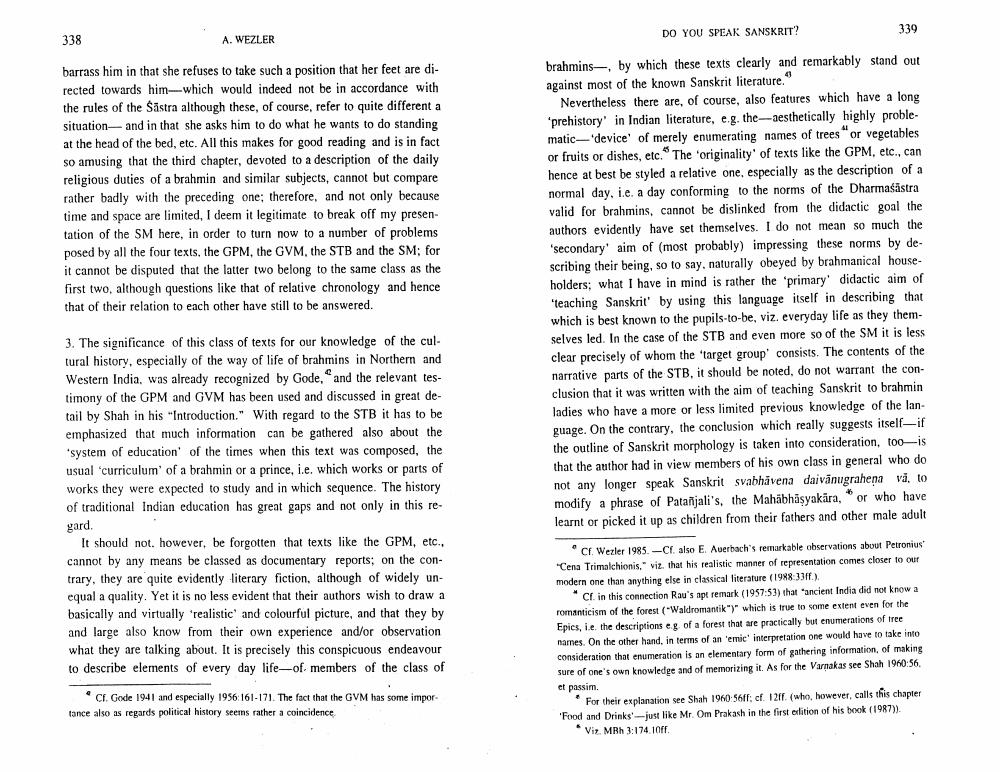________________
338
A. WEZLER
DO YOU SPEAK SANSKRIT?
339
barrass him in that she refuses to take such a position that her feet are directed towards him which would indeed not be in accordance with the rules of the Sastra although these, of course, refer to quite different a situation and in that she asks him to do what he wants to do standing at the head of the bed, etc. All this makes for good reading and is in fact so amusing that the third chapter, devoted to a description of the daily religious duties of a brahmin and similar subjects, cannot but compare rather badly with the preceding one; therefore, and not only because time and space are limited, I deem it legitimate to break off my presentation of the SM here, in order to turn now to a number of problems posed by all the four texts, the GPM, the GVM, the STB and the SM; for it cannot be disputed that the latter two belong to the same class as the first two, although questions like that of relative chronology and hence that of their relation to each other have still to be answered.
brahmins by which these texts clearly and remarkably stand out against most of the known Sanskrit literature."
Nevertheless there are, of course, also features which have a long 'prehistory' in Indian literature, e.g. the-aesthetically highly problematic-"device of merely enumerating names of trees or vegetables or fruits or dishes, etc. The originality' of texts like the GPM, etc., can hence at best be styled a relative one, especially as the description of a normal day, i.e. a day conforming to the norms of the Dharmasastra valid for brahmins, cannot be dislinked from the didactic goal the authors evidently have set themselves. I do not mean so much the 'secondary aim of (most probably) impressing these norms by de. scribing their being, so to say, naturally obeyed by brahmanical householders; what I have in mind is rather the primary' didactic aim of "teaching Sanskrit' by using this language itself in describing that which is best known to the pupils-to-be, viz. everyday life as they themselves led. In the case of the STB and even more so of the SM it is less clear precisely of whom the target group' consists. The contents of the narrative parts of the STB, it should be noted, do not warrant the conclusion that it was written with the aim of teaching Sanskrit to brahmin ladies who have a more or less limited previous knowledge of the language. On the contrary, the conclusion which really suggests itsell-if the outline of Sanskrit morphology is taken into consideration, too-is that the author had in view members of his own class in general who do not any longer speak Sanskrit svabhävena daivānugrahena vd, to modify a phrase of Patanjali's, the Mahabhāsyakára, or who have learnt or picked it up as children from their fathers and other male adult
3. The significance of this class of texts for our knowledge of the cultural history, especially of the way of life of brahmins in Northern and Western India, was already recognized by Gode, and the relevant testimony of the GPM and GVM has been used and discussed in great detail by Shah in his "Introduction." With regard to the STB it has to be emphasized that much information can be gathered also about the
system of education of the times when this text was composed, the usual curriculum' of a brahmin or a prince, i.e. which works or parts of works they were expected to study and in which sequence. The history of traditional Indian education has great gaps and not only in this re
gard,
It should not, however, be forgotten that texts like the GPM, etc., cannot by any means be classed as documentary reports on the contrary, they are quite evidently literary fiction, although of widely unequal a quality. Yet it is no less evident that their authors wish to draw a basically and virtually realistic and colourful picture, and that they by and large also know from their own experience and/or observation what they are talking about. It is precisely this conspicuous endeavour to describe elements of every day life-of members of the class of
Cr Werler 1985.-falso E Auerbach's remarkable observations about Petronius "Cena Trimalchionis. viz. that his realistic manner of representation comes closer to our modern one than anything else in classical literature (1988: 33ff.)
*Cl in this connection Rau's apt remark (1957:53) that 'ancient India did not know a romanticism of the forest ("Waldromantik")" which is true to some extent even for the Epics, ie the descriptions eg of a forest that are practically but enumerations of tree namnes. On the other hand, in terms of an emic interpretation one would have to take into consideration that enumeration is an elementary form of gathering information of making sure of one's own knowledge and of memorizing it. As for the Varnakas see Shah 1960 56. ct passim.
For their explanation see Shah 1960:56ff: cf 1201 (who, however, calls this chapter 'Food and Drinks - just like Mr. Om Prakash in the first edition of his book (1987)).
Viz MRh 3:174 10ff
C. Gode 1941 and especially 1956:161-171. The fact that the GVM has some impor tance also as regards political history seems rather a coincidence




